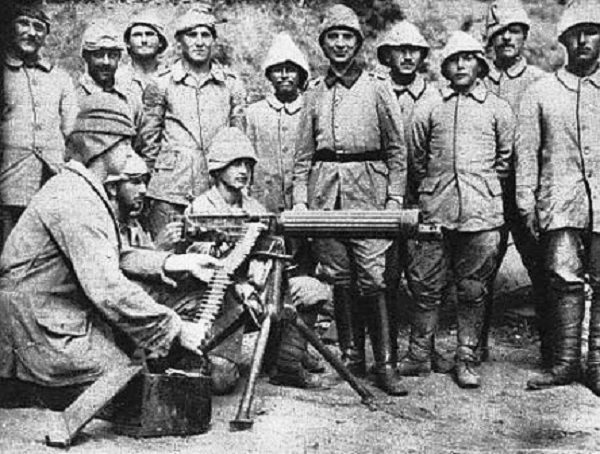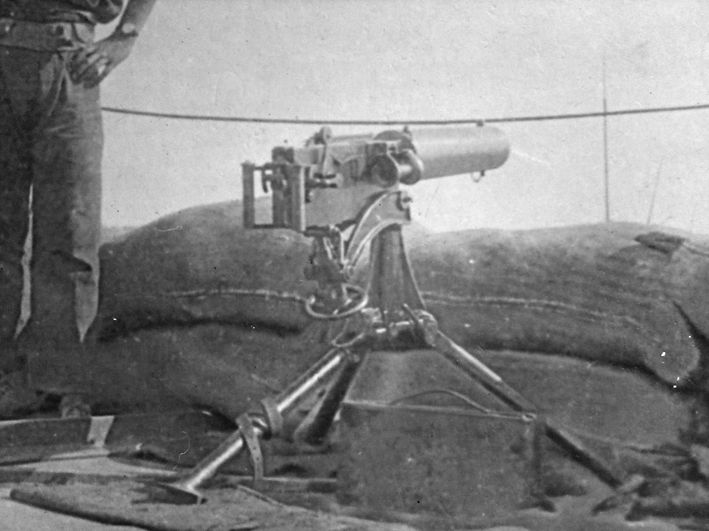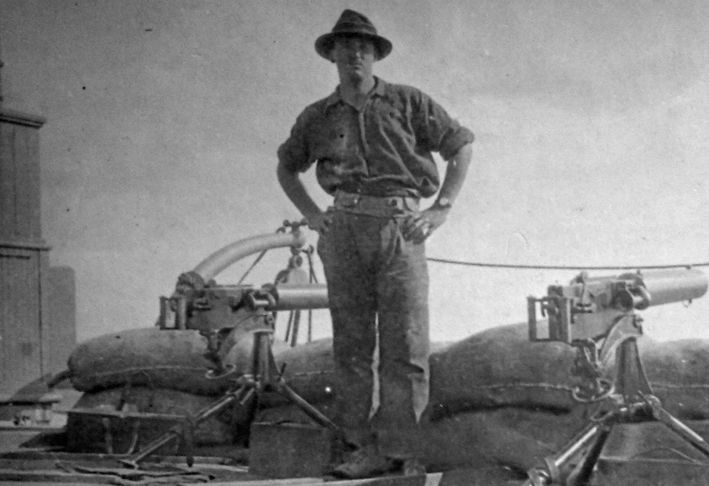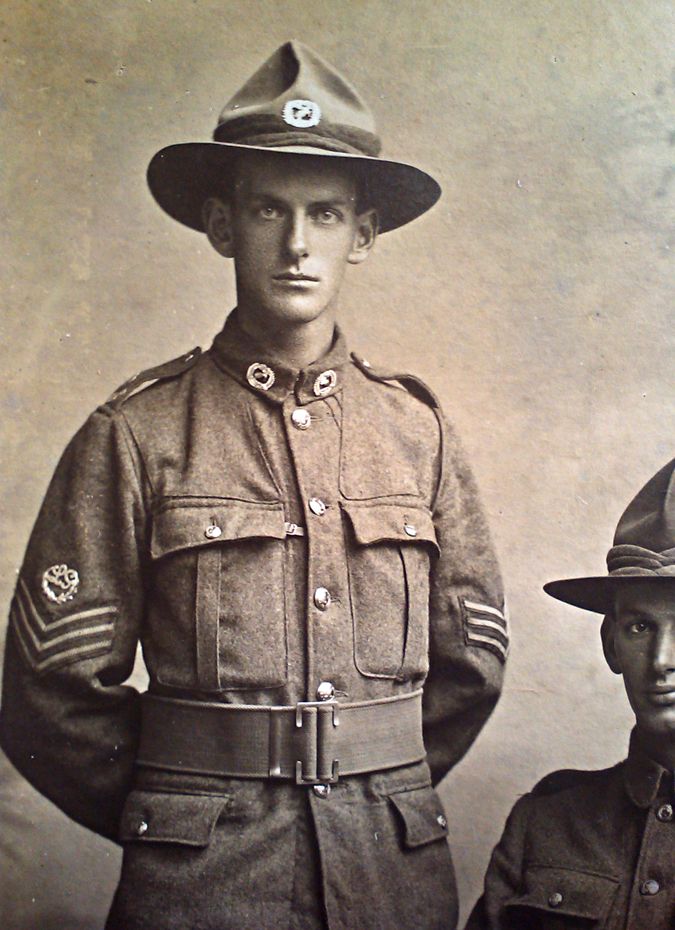
 |
Recent Books by Forum Members |

 |
 |
|
|
|||||||
 |
|
|
Thread Tools | Display Modes |
|
#181
|
||||
|
||||
|
Quote:
I think the odds will be in my favour once I flush out another green star. |
|
#182
|
|||
|
|||
|
Quote:
Thanks for your comment regarding Major Applin. While not disagreeing with you regarding Applin, there are misperceptions about machine guns in the early part of the war, and especially about the British use of them. The British were, in fact, leaders in the use of machine guns, acquiring the Maxim in 1889, and by 1900 had them in their infantry battalions and cavalry regiments. Contrary to popular opinion the Germans were reluctant to adopt machine guns. In 1898, after seeing them in British units, the Kaiser directed the German Army to trial the Maxim. Even after the trials the German Army was reluctant to adopt the gun, giving them to a few Jager units that accompanied the Cavalry divisions, who regarded the Maxim as "an impediment". It was only after the Russo-Japanese War that the German Army saw their real potential and introduced into them as a six gun company alloted to their infantry regiments, ( roughly equivalent to a British brigade) some eighteen years after the British first adopted the Maxim. The following is an extract from my forthcoming book The Landing at Anzac, 1915 which discusses very basically the use of the guns in 1914, based on the doctrine employed in both amies. The Ottoman Army employed German doctrine. "Although they were highly effective weapons when brought into action, in reality, all armies were still coming to terms with the machine-gun and, in the years leading up to the war, there was considerable debate on its employment. In 1914 machine-guns were employed quite differently to the way they are used today, and their employment resembled that of artillery batteries and sections, rather than as an integral element of the rifle platoon as they were to become later in the war when the lighter Lewis gun was introduced. The Maxim machine-gun was a heavy, cumbersome, crew-served, automatic weapon. With its sled and water cooling system, the gun weighed 69 kilograms and, together with its boxes of ammunition, was carried in a wagon, on a gun carriage or by pack animal to provide tactical mobility. When dismounted and manhandled by the crew, these guns were considerably less mobile. Although the British Vickers gun (1912) was lighter, the Australian and New Zealand battalions used Maxim guns at Gallipoli until sufficient numbers of Vickers became available later in the campaign. Fed with a 250-round belt, the Maxim was capable of firing 400 to 500 rounds per minute at the sustained rate; however they had an enormous appetite for ammunition and a propensity to overheat which led to jamming. Consequently, training emphasised traversing fire in short bursts of five to 10 rounds, while rapid fire against concentrated targets involved bursts of 30 to 50 rounds. British and German pre-war doctrine generally agreed on their employment on the battlefield in both attack and defence, and either frontally or on a flank. The difference lay in the preferred methods of control and deployment of the guns, and in this the Ottomans followed German doctrine. The British regarded the machine-gun as a powerful auxiliary, well adapted for close cooperation with the infantry, and a weapon of opportunity delivering concentrated fire against favourable targets. They incorporated the machine-gun within the battalion in a section of two guns under the battalion commander’s control where the gun was considered better able to support the infantry. However, the British also recognised the utility of massed guns and allowed two or more sections to be grouped as a battery under the brigade machine-gun officer where they were used as a powerful reserve for the brigade commander. At the ANZAC landing, for example, the 2nd Australian Brigade brigaded the guns of the 6th and 8th battalions, while those of the 5th and 7th remained under battalion control. The Ottoman machine-gunners were a separate branch to the infantry. They grouped four guns in a company which was assigned to an infantry regiment (brigade) where they were used as a mobile reserve or for general support directed by the regimental commander. They were not averse to splitting the company into two platoons (two guns) in close support of the battalions, but again this occurred under the control of the regimental commander. Due to the Maxim’s tendency to jam, deployment of single guns was actively discouraged and in some cases forbidden. Thus while the British preference was to employ the guns at battalion level, the Germans and Ottomans preferred to employ the company as a battery at regimental level where it was considered their tactical mobility and combined firepower could be better utilised and ammunition resupply was easier. In both armies, when used in sections (or platoons) the guns were deployed in pairs and sited alongside each other with a spacing of 17 to 20 paces, although contemporary photos taken early in the war show the guns sited closer together. When employed as a battery they deployed much the same as an artillery battery in line abreast, with each pair assigned a specific target and supported by a range finder. In defence, while the guns could be placed in the firing line at the outset, the pre-war doctrine of both armies advocated holding them back as a fire reserve that could ‘respond quickly to a threatened point’ and ‘with decisive effect’. The German regulations cautioned that, while machine-guns were excellent defensive weapons, employing them in a static defence (pre-positioned in the firing line) deprived them of their mobility, whereas using them in active defence (identifying the threat and then deploying them to where the need was greatest) better utilised this scarce and valuable resource. Thus commanders were urged to use their machine-guns as a reserve and deploy them once the point of greatest threat had been identified. Regulations stressed that suitable positions should be reconnoitred beforehand to enable the guns to be brought into action quickly. " Interestingly, contrary to popular myth, Haig was a great supporter of the machine gun. On being posted to fight in the Sudan War in 1898, on his own initiative he undertook a course in their use prior to going to the war, and during the conflict wrote on their use and how they could be better employed. Regards Chris |
|
#183
|
||||
|
||||
|
Chris, I must admit I have not come across your book “Landing at Anzac,” but your last interesting post remided me of an article.— “Turkish machine-guns at the landing” that I have read on the Australian War Memorial web site.
http://www.awm.gov.au/wartime/50/roberts_machinegun/ Very interesting indeed. The following is the first part of the short history of the NZ Machine gunners that I mentioned in post #27. New Zealand’s history of the Machine Gun dates back to April 1889, when Major-General T. Bland Strange (Royal Artillery) on behalf of the manufacturers, brought a Maxim machine gun to New Zealand with a view to inducing the NZ Government to invest. Major General Strange demonstrated the Maxim throughout New Zealand, with the first demonstration held at St. Clair Battery in Dunedin on the 16th April 1889. (The Maxim gun was discharged into the sea) After a successful demonstration of the Maxim in the presence of the members of the Legislature in Wellington on the 29th June 1889, the NZ Government purchased one Maxim machine gun, with the view to purchasing seven more. The object at the time was to detail two Maxim machine guns for each of the four main ports— Dunedin, Lyttelton, Wellington, and Auckland. (General Strange demonstrated the Maxim in Australia before he arrived in New Zealand, selling a total of 36 Maxims. New South Wales — 12; Victoria —10; Queensland — 10; Tasmania — 4) |
|
#184
|
|||
|
|||
|
Thanks Brent. Interesting stuff.
The book will be out in April. The article on the AWM site was mine. Cheers Chris |
|
#185
|
||||
|
||||
|
Chris do you have any evidence that the New Zealanders or the Australians used the Vickers machine gun during the Gallipoli campaign?
|
|
#186
|
|||
|
|||
|
Hi Brent,
My understanding is that most Anzac units were issued with the Maxim at Gallipoli, and they certainly had it at the landing, not the Vickers. Most people and many historians assume the Anzacs used the Vickers at Gallipoli, indeed, several photos of Maxims on Gallipoli are labeled as Vickers guns. Maxims were used throughout the campaign, however, some Australian units were issued with Vickers guns, but I have yet to determine when they were first used. I am not sure if the Kiwis were. If you do a search of the AWM/Collections/advanced search. The photo JO2704 shows the Vickers of the 9th ALH on Turks Point. I think most ANZAC units changed over to the Vickers in early 1916. Cheers Chris |
|
#187
|
|||
|
|||
|
Hi
Further images can be found in the AWM collections data base of Australian troops using Vickers machine guns by typing 'Vickers' in the search engine. Some of these include: H03494 Gallipoli. 1915. Australian soldiers operating a Vickers machine gun mounted for defence against aircraft attacks. H14026 Gallipoli, Turkey. 1915. An AIF Vickers machine gun crew of A Company of either the 22nd or 24th Battalion. P08137.002 An Australian Vickers .303 machine gun crew, probably sited at Plugges Plateau, firing on Turkish positions through a gap in a stone wall. P08137.003 An Australian soldier firing a Vickers .303 machine gun on Turkish positions. Lit by sunlight through the observation hole at right, the post one of many in the extensive array of tunnels connecting the Australian front line positions. Cheers John |
|
#188
|
||||
|
||||
|
Quote:
All the photos that I have found of Australian machine guns during the Gallipoli campaign, appear to be Maxims. I had already checked the AWM/Collections looking for photos of machine guns, and must admit, I missed the photo of the 9th ALH on Turks Point, which certainly shows undeniable evidence that the Australians had the Vickers Mk1 machine gun on Gallipoli, which helps explain this photo that I found on this interesting site. http://www.gallipoli-association.org...day/october-27  Quote:
I have a January 1916 New Zealand newspaper which shows the same photo as “P08137.002,” interestingly, it mentions that it is New Zealanders pictured, although the hat the chap is wearing on the right, wasn't typically worn by New Zealanders. |
|
#189
|
|||
|
|||
|
A January paper with old Gallipoli Anzac news . Our lads were gone before Christmas 1915 .
And has been pointed out , it wasn't a NZ machine gun in the photo . Journalists eh The NZEF got the Vickers as part of the reorganisation after the Fiasco was over . Quote:
Jock |
|
#190
|
|||
|
|||
|
Thank you for that information Brent and Jock. Much appreciated.
I also thought several of the photos John put up were Maxims, but looking closely at H14026, P08137.002 and P08137.003 the tripod mounts they are on look more like the Vicker's tripod than the Maxim tripod. Cheers Chris |
|
#191
|
|||
|
|||
|
Chris ,
this may well be why . Quote:
Jock |
|
#192
|
|||
|
|||
|
Thank you Jock. It certainly explains the confusion I had with the photos.
Cheers Chris |
|
#193
|
|||
|
|||
|
Chris
It may be that the high elevation was wanted for Indirect Fire at Gallipoli. This was used to excellent effect on the Western Front. Jock |
|
#194
|
||||
|
||||
|
Just a couple of one pic I own, I have seen one other cpy before it was captioned on the back the man was a NZ officer and a early Casualty at Gallipoli , just a close up of one of the guns
  Just for brent to compare with his earlier pic of the "LG" pic 1917 in Cornwall UK. 
|
|
#195
|
|||
|
|||
|
sigcollector,
They look like Vickers machine guns. See the side of the gun between the firing handles and where the belt is inserted, and the 'ridge' along the top and compare with the attachments. I'm inclined to think P08137.002 might be a Vickers. The real tell tale is the length of the water jacket Cheers Chris Last edited by Chrisr; 16-01-13 at 01:51 AM. |
 |
|
|
 |